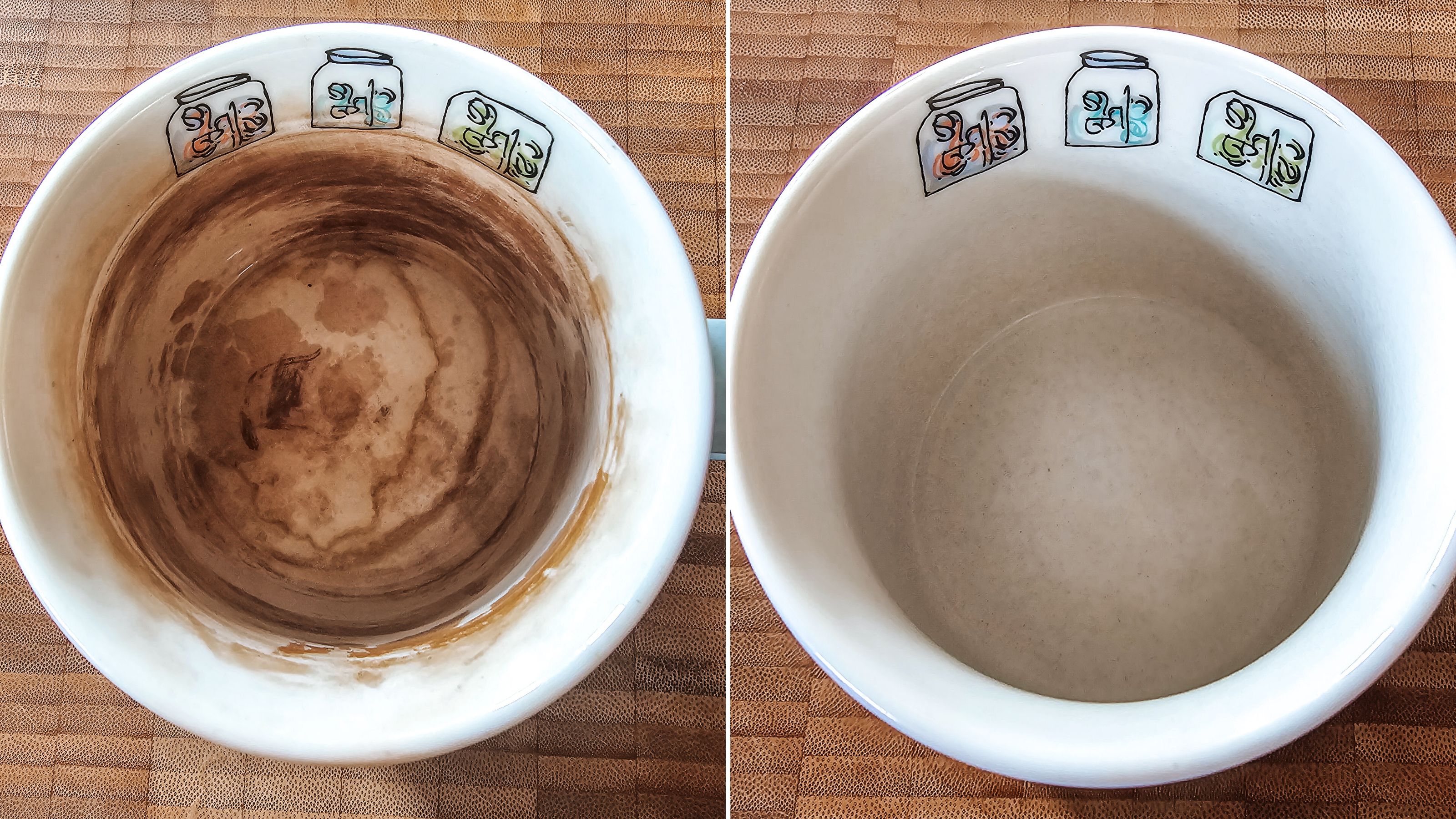As an Amazon Associate I earn from qualifying purchases.
Have you ever noticed those stubborn coffee stains lingering in your favorite mug? You know the ones—those brownish rings that seem to defy every scrub and soak.
If you’ve ever wondered why coffee leaves its mark on your cherished cup, you’re not alone. This common yet curious phenomenon has puzzled many coffee lovers like you. But here’s the intriguing part: understanding the science behind these stains can change the way you approach your daily brew.
Dive into this fascinating topic and discover not just the why, but also how you can keep your mugs spotless and enjoy your coffee ritual even more. Stick around, and you’ll never look at your coffee cup the same way again!

Credit: www.realhomes.com
Composition Of Coffee
Have you ever wondered why your favorite coffee mugs often bear stubborn stains? The answer lies in the fascinating composition of coffee. Coffee, a complex brew, contains a variety of elements that interact with the surface of your mug. Understanding these components can help you tackle those pesky stains effectively.
Tannins And Their Role
Tannins are natural compounds found in coffee. They are responsible for the rich, dark color and slightly bitter taste. These compounds have a strong affinity for surfaces, which is why they cling to the inside of your mug. Imagine tannins as tiny artists painting your mug with each sip you take. Their strong bonding abilities make them notorious for leaving behind visible stains.
Next time you enjoy your morning coffee, consider using a mug that is less porous. A smoother surface can reduce the grip tannins have, minimizing staining. It’s a small switch that can make your mug cleaning routine much easier.
Acidity And Residue Formation
Coffee’s acidity plays a significant role in residue formation. The acidic nature of coffee can react with the mug’s surface, especially if it’s made from a reactive material. This reaction forms a residue that contributes to staining. Picture your coffee as a gentle rain eroding a rock, slowly leaving marks over time.
One way to combat this is by occasionally switching to a less acidic coffee blend. This can lessen the chemical interaction and reduce residue formation. Have you noticed some mugs stain more than others? It might be time to experiment with different coffee types or mug materials.
Stains on mugs can be a nuisance, but understanding the components of coffee can help you manage them. So, what’s your favorite mug story? Perhaps a stain that reminds you of a cherished morning ritual?

Credit: barkeepersfriend.com
Surface Of Mug Materials
The surface of mug materials affects how easily coffee stains them. Different materials have unique properties. These properties determine how they interact with coffee. Understanding these surfaces can help in choosing the right mug. Let’s dive into the details.
Porosity Of Ceramic
Ceramic mugs are popular. They often have a porous surface. This porosity means tiny holes cover the surface. Coffee particles can settle in these holes. This leads to staining. The porous nature also absorbs oils from coffee. This further deepens the stain over time.
Stainless Steel Characteristics
Stainless steel mugs are less porous. They have a smoother surface. This makes them less prone to staining. Coffee stains can still form, but they are easier to clean. The metal surface reflects light. This can make stains less visible. Regular cleaning helps maintain their shiny appearance.
Glass And Plastic Differences
Glass mugs offer a smooth, non-porous surface. This makes coffee stains less likely to stick. Glass does not absorb oils. This keeps it looking clean for longer. Plastic mugs vary in quality. Some are more porous than others. Cheaper plastics may stain easily. Higher quality plastics resist staining better.
Interaction Between Coffee And Mugs
Have you ever wondered why your favorite coffee mug seems to be forever marked by stubborn stains? The interaction between coffee and mugs is an intriguing dance of chemistry and physics. Understanding how temperature and time influence these stains can offer insights and perhaps solutions for keeping your mugs pristine.
Temperature Effects
The temperature of your coffee plays a significant role in staining your mug. Hot coffee tends to have more staining power than cold coffee. The heat causes the molecules in the coffee to move faster, which can lead to a stronger interaction with the surface of the mug.
Consider this: when you pour a steaming cup of coffee, the heat opens up the pores in your ceramic mug. This allows the coffee’s natural oils and tannins to seep into the surface. As the mug cools, these compounds settle, creating a stain that can be tough to remove.
Time And Stain Intensity
The longer your coffee sits in a mug, the more intense the stain becomes. This is because the compounds in coffee have more time to interact with the mug’s surface. Even if you rinse your mug immediately, some staining is inevitable with extended exposure.
Imagine leaving your coffee in a mug while you get distracted with emails or chores. Each minute adds layers to the stain, making it more challenging to clean later. Have you tried scrubbing away a day-old coffee stain? It’s a task that often requires more than just soap and water.
Can you think of moments when you left a mug unattended? How did the stain affect your cleaning routine? Understanding these interactions can help you manage and minimize stains, keeping your mugs looking fresh for longer.
Cleaning Challenges
Coffee leaves stubborn stains due to its natural oils and tannins. These compounds cling to the mug’s surface. Regular cleaning can help prevent buildup and maintain a fresh look.
Cleaning coffee mugs can be a real challenge. Coffee leaves stubborn stains that cling to mug surfaces. These stains are more than just unsightly marks. They are a mix of tannins and oils from coffee beans. Over time, these substances form a sticky residue that clings to mug surfaces. Regular washing often doesn’t remove them completely.
Common Cleaning Methods
People try different methods to clean coffee stains. Many use hot water and dish soap as a first step. Scrubbing with a sponge or brush is common. Some people use baking soda for tougher stains. They sprinkle it on a damp cloth and scrub the mug. Vinegar is another popular choice. It can help break down stubborn stains. Each method varies in effectiveness.
Effectiveness Of Detergents
Detergents promise to make cleaning easier. Many people rely on them to remove coffee stains. Not all detergents work the same way. Some are designed specifically for tough stains. These can be more effective than regular dish soaps. It’s important to choose the right product. Some may leave residues or odors if not rinsed well. Testing different detergents can help find the best one for your mugs.
Preventing Coffee Stains
Coffee leaves stains on mugs because it contains tannins. These natural compounds stick to surfaces, causing discoloration. Porous mug materials, like ceramic, absorb these tannins more easily, leading to noticeable stains over time.
Preventing coffee stains on your favorite mug isn’t just about keeping it looking pristine. It also adds to the enjoyment of that perfect cup of joe. Imagine sipping your morning coffee from a mug that always looks fresh and inviting. It’s possible with a few simple tricks. Let’s dive into how you can keep those pesky stains at bay.
Choosing The Right Mug
The material of your mug plays a crucial role in preventing stains. Porcelain and glass mugs are less likely to stain compared to ceramic or plastic ones. They have smoother surfaces, making it harder for coffee particles to cling. Color matters too. Darker mugs may hide stains better, but they don’t prevent them. If you prefer a clean look, a white porcelain mug is a great choice. It’s easier to spot stains early and deal with them before they set in.
Routine Maintenance Tips
Regular cleaning is your best defense against stains. Rinse your mug immediately after finishing your coffee. This simple step prevents residue from drying and staining. Try using baking soda for stubborn stains. Sprinkle a small amount on a damp sponge and scrub gently. It’s a natural and effective way to keep your mug spotless. Consider designating a specific mug for coffee. It limits the spread of stains to other cups in your collection. Plus, it becomes your trusty companion for every coffee break. How do you keep your favorite mug free from coffee stains? Share your tips in the comments. Your perfect coffee experience might inspire someone else!
Scientific Insights
Understanding why coffee stains mugs involves exploring scientific insights. Coffee’s complex chemistry plays a vital role in staining. The pigments and acids in coffee interact with mug surfaces. These interactions create stubborn stains. Let’s dive deeper into the science behind this phenomenon.
Research On Staining Mechanisms
Researchers have studied coffee’s staining properties extensively. Coffee contains tannins, which bind to surfaces. Tannins are naturally occurring compounds in coffee. They have a strong affinity for ceramic and glass. This binding leads to visible stains over time.
Acidity also contributes to stains. Coffee’s acidic nature affects mug materials. Acids can etch surfaces, allowing pigments to penetrate. The combination of tannins and acids is powerful. Together, they create lasting stains on mugs.
Future Innovations In Stain Prevention
Scientists are exploring ways to prevent coffee stains. New coatings for mugs are under development. These coatings repel tannins and acids. They aim to keep mugs stain-free longer.
Material science offers promising solutions. Advanced ceramic technologies resist staining. They provide mugs with enhanced durability. These innovations could change how mugs handle coffee stains. The future of stain prevention looks bright.

Credit: www.youtube.com
Frequently Asked Questions
Why Do Coffee Mugs Stain?
Coffee contains tannins, which are compounds that cause staining. These tannins bind with the mug’s surface, leaving behind a brownish residue. Porous materials like ceramics absorb these stains more easily. Regular cleaning can help prevent buildup, but over time, the stains can become more stubborn to remove.
How Can I Remove Coffee Stains From Mugs?
To remove coffee stains, use baking soda or vinegar. Sprinkle baking soda inside the mug and scrub with a damp sponge. Alternatively, soak the mug in a mixture of vinegar and water. Rinse thoroughly after cleaning to ensure all residues are removed.
Regular cleaning can prevent future stains.
Are Certain Mugs More Prone To Staining?
Yes, mugs made from porous materials, like ceramic, stain more easily. These materials absorb tannins from coffee, leading to discoloration. Glazed ceramics may resist staining better than unglazed ones. Glass and stainless steel mugs are less prone to staining but can still develop residues over time.
Does Coffee Type Affect Staining?
Yes, darker roasts typically contain more tannins, leading to more staining. Additionally, brewed coffee left sitting in a mug longer can increase stain buildup. Regularly cleaning your mug helps mitigate this. Using lighter roasts or rinsing the mug promptly can reduce staining potential.
Conclusion
Coffee stains mugs due to its tannins and oils. These compounds cling to ceramic surfaces. Regular cleaning helps reduce stains. Use baking soda or vinegar for stubborn marks. Avoid leaving coffee in mugs too long. Rinse mugs right after use.
This prevents stains from setting. A clean mug enhances the coffee experience. It also looks more inviting. Understanding why stains occur helps. It makes managing them easier. Enjoy your coffee without stain worries. Keep your mugs fresh and bright. A little effort goes a long way.
Your morning routine stays pleasant and stain-free.
As an Amazon Associate I earn from qualifying purchases.

Sohel Rana is a seasoned author whose passion for home and kitchen essentials permeates through his writing. Born and raised in a small town nestled amidst lush greenery, Rana’s fascination with the intricacies of domestic life blossomed from an early age. His upbringing in a close-knit family environment instilled in him a deep appreciation for the importance of a well-equipped kitchen and a cozy home

